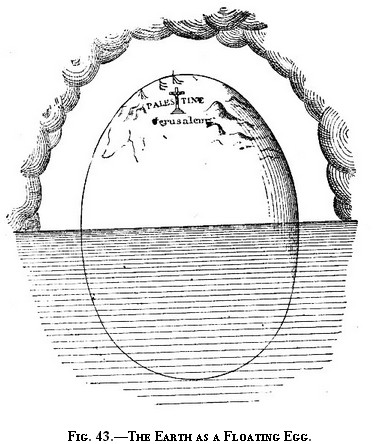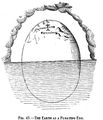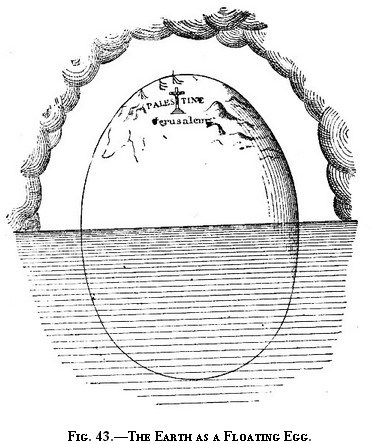File:Fig 43.-The Earth As A Floating Egg.jpg
Fig_43.-The_Earth_As_A_Floating_Egg.jpg (381 × 444 pixels, file size: 51 KB, MIME type: image/jpeg)
This last sentence shows that however far he may have been from the truth, he did not, like so many of his contemporaries, stumble over the idea of up and down in the universe, and so consider the notion of antipodes absurd.

A great number of the maps of the world of the period followed this idea, and drew the world in the shape of an egg at rest. It was broached, however, in another form by Edrisi, an Arabian geographer of the eleventh century, who, with many others, considered the earth to be like an egg with one half plunged into the water. The regularity of the surface is only interrupted by valleys and mountains. He adopted the system of the ancients, who supposed that the torrid zone was uninhabited. According to him the known world only forms a single half of the egg, the greater part of the water belonging to the surrounding ocean, in the midst of which earth floats like an egg in a basin. Several artists and map-makers adopted this theory in the geographical representations, and so, whether in this way or the last, the egg has had the privilege of representing the form of the earth for nearly a thousand years.
The celebrated Raban Maur, of Mayence, composed in the ninth century a treatise, entitled De Universo, divided into twenty-two books. It is a kind of encyclopædia, in which he gives an abridged view of all the sciences. According to his cosmographic system the earth is in the form of a wheel, and is placed in the middle of the universe, being surrounded by the ocean; on the north it is bounded by the Caucasus, which he supposes to be mountains of gold, which no one can reach because of dragons, and griffins, and men of monstrous shape that dwell there. He also places Jerusalem in the centre of the earth.John F. Blake, Macmillan and Co., pp. 272-275, 1877, http://www.gutenberg.org/files/36495/36495-h/36495-h.htm#Page_273.
File history
Click on a date/time to view the file as it appeared at that time.
| Date/Time | Thumbnail | Dimensions | User | Comment | |
|---|---|---|---|---|---|
| current | 11:33, 24 February 2014 |  | 381 × 444 (51 KB) | Sahab (talk | contribs) | {{Quote|{{cite web quotebox| url = http://www.gutenberg.org/files/36495/36495-h/36495-h.htm#Page_273| title = Astronomical Myths: Based on Flammarions's History of the Heavens| publisher = Macmillan and Co.| author = John F. Blake| date = 1877|pages=27... |
You cannot overwrite this file.
File usage
The following page uses this file:
